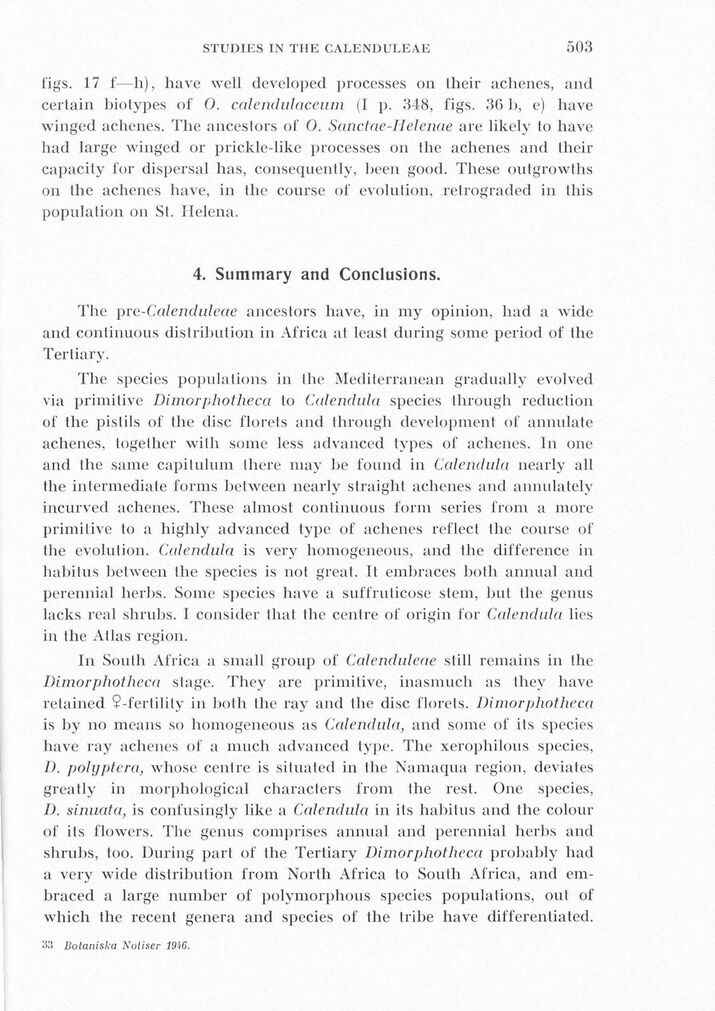
Full resolution (JPEG) - On this page / på denna sida - Sidor ...

<< prev. page << föreg. sida << >> nästa sida >> next page >>
Below is the raw OCR text
from the above scanned image.
Do you see an error? Proofread the page now!
Här nedan syns maskintolkade texten från faksimilbilden ovan.
Ser du något fel? Korrekturläs sidan nu!
This page has never been proofread. / Denna sida har aldrig korrekturlästs.
STUDIES IN THE CALENDULEAE
503
figs. 17 f—Ii), have well developed processes ön their achenes, and
certain biotypes of O. calendiilaceum (I p. 348, figs. 36 b, e) have
winged achenes. The ancestors of O. Sanctne-Helenae are likely lo have
had large winged or prickle-like processes ön llie achenes and their
capacity lbr dispersal has, consequently, been good. These outgrowths
ön Ihe achenes have, in Ihe course of evolution, retrograded in this
populalion ön St. Helena.
4. Summary and Conclusions.
The pre-Calenduleae ancestors have, in my opinion, had a wide
and continuous distribution in Africa al leasl during some period of the
Tertiary.
The species populations in the Mediterranean gradually evolved
via primitive Dimorphotheea lo Calendula species Ihrough reduction
of the pist ils of the disc florets and through development of annulate
achenes, together with some less advanced tvpes of achenes. In one
and Ihe same capilulum |here may be found in Calendula nearly all
the intermediate forms between nearly straight achenes and annulately
incurved achenes. These almost continuous form series from a möre
primitive lo a highly advanced type of achenes reflect tlie course of
the evolution. Calendula is verv homogeneous, and the difference in
habitus between Ihe species is not great. 11 embraces bolh annual and
perennial lierbs. Some species have a suffrulicose stein, hut Ihe genus
lacks real shrubs. 1 consider that Ihe centre of origin for Calendula lies
in the /Vilas region.
In South Africa a small group of Calenduleae slill remains in the
Dimorphotheea stage. They are primitive, inasmuch as they have
retained 9-ferlilily in bolh the ray and the disc florets. Dimorphotheea
is by no means so homogeneous as Calendula, and some of ils species
have ray achenes of a much advanced type. The xerophilous species,
D. polyptera, whose centre is situated in Ihe Namaqua region, deviates
greally in morphological characters from the rest. One species,
D. sinuata, is confusingly like a Calendula in its habitus and Ihe colour
of ils flowers. The genus comprises annual and perennial lierbs and
shrubs, loo. During part of Ihe Tertiary Dimorphotheea probably had
a verv wide distribution from North Africa lo South Africa, and
em-braced a large number of polymorphous species populations, out of
which the recent genera and species of the tribe have differentiated.
33 Botaniska Noliser 1946.
<< prev. page << föreg. sida << >> nästa sida >> next page >>